Related Research Articles
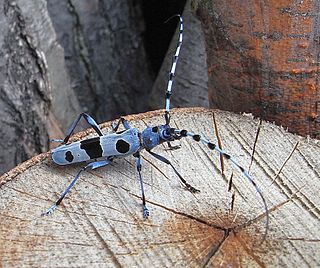
Antennae, sometimes referred to as "feelers", are paired appendages used for sensing in arthropods.
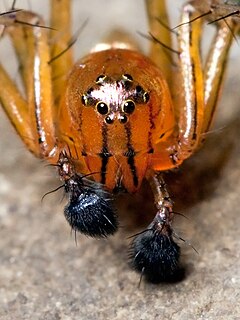
Pedipalps are the second pair of appendages of chelicerates – a group of arthropods including spiders, scorpions, horseshoe crabs, and sea spiders. The pedipalps are lateral to the chelicerae ("jaws") and anterior to the first pair of walking legs.

The hummingbird hawk-moth is a species of moth. It was first described by Carl Linnaeus in his 1758 10th edition of Systema Naturae. As of 2018, its entire genome and mitogenome have been sequenced.

The Sphingidae are a family of moths (Lepidoptera), commonly known as hawk moths, sphinx moths, and hornworms; it includes about 1,450 species. It is best represented in the tropics, but species are found in every region. They are moderate to large in size and are distinguished among moths for their agile and sustained flying ability, similar enough to that of hummingbirds as to be reliably mistaken for them. Their narrow wings and streamlined abdomens are adaptations for rapid flight. The family was named by French zoologist Pierre André Latreille in 1802.

Microlepidoptera (micromoths) is an artificial grouping of moth families, commonly known as the 'smaller moths'. These generally have wingspans of under 20 mm, and are thus harder to identify by external phenotypic markings than macrolepidoptera. They present some lifestyles which the larger Lepidoptera do not have, but this is not an identifying mark. Some hobbyists further divide this group into separate groups, such as leaf miners or rollers, stem or root borers, and then usually follow the more rigorous scientific taxonomy of lepidopterans. Efforts to stabilize the term have usually proven inadequate.

The decapod crustacean, such as a crab, lobster, shrimp or prawn, is made up of 20 body segments grouped into two main body parts: the cephalothorax and the pleon (abdomen). Each segment may possess one pair of appendages, although in various groups these may be reduced or missing. They are, from head to tail:
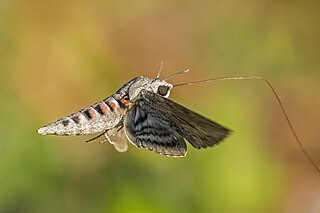
Agrius convolvuli, the convolvulus hawk-moth, is a large hawk-moth. It is common throughout Europe, Asia, Africa, Australia and New Zealand, partly as a migrant. In New Zealand, it is also known in the Māori language as hīhue.

This glossary of entomology describes terms used in the formal study of insect species by entomologists.
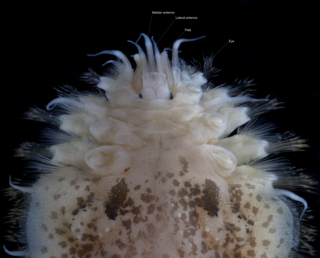
The prostomium is the cephalized first body segment in an annelid worm's body at the anterior end. It is in front of the mouth, being usually a small shelf- or lip-like extension over the dorsal side of the mouth. The prostomium together with the peristomium, which includes the mouth and pharynx, make up the annelid head.

A tympanal organ is a hearing organ in insects, consisting of a membrane (tympanum) stretched across a frame backed by an air sac and associated sensory neurons. Sounds vibrate the membrane, and the vibrations are sensed by a chordotonal organ. Hymenoptera do not have a tympanal organ, but they do have a Johnston's organ.

Megacorma obliqua, the black-belted hawkmoth, is a moth of the family Sphingidae.

The mandible of an arthropod is a pair of mouthparts used either for biting or cutting and holding food. Mandibles are often simply referred to as jaws. Mandibles are present in the extant subphyla Myriapoda, Crustacea and Hexapoda. These groups make up the clade Mandibulata, which is currently believed to be the sister group to the rest of arthropods, the clade Arachnomorpha.

In arthropods, the maxillae are paired structures present on the head as mouthparts in members of the clade Mandibulata, used for tasting and manipulating food. Embryologically, the maxillae are derived from the 4th and 5th segment of the head and the maxillary palps; segmented appendages extending from the base of the maxilla represent the former leg of those respective segments. In most cases, two pairs of maxillae are present and in different arthropod groups the two pairs of maxillae have been variously modified. In crustaceans, the first pair are called maxillulae.

Insects have a range of mouthparts, adapted to particular modes of feeding. The earliest insects had chewing mouthparts. Specialization has mostly been for piercing and sucking, although a range of specializations exist, as these modes of feeding have evolved a number of times (for example, mosquitoes and aphids both pierce and suck, however female mosquitoes feed on animal blood whereas aphids feed on plant fluids. In this page, the individual mouthparts are introduced for chewing insects. Specializations are generally described thereafter.
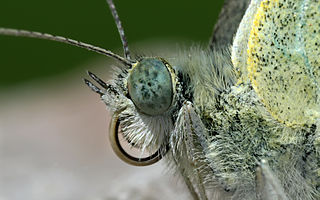
The external morphology of Lepidoptera is the physiological structure of the bodies of insects belonging to the order Lepidoptera, also known as butterflies and moths. Lepidoptera are distinguished from other orders by the presence of scales on the external parts of the body and appendages, especially the wings. Butterflies and moths vary in size from microlepidoptera only a few millimetres long, to a wingspan of many inches such as the Atlas moth. Comprising over 160,000 described species, the Lepidoptera possess variations of the basic body structure which has evolved to gain advantages in adaptation and distribution.
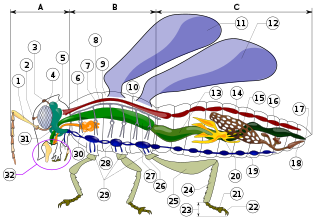
Insect morphology is the study and description of the physical form of insects. The terminology used to describe insects is similar to that used for other arthropods due to their shared evolutionary history. Three physical features separate insects from other arthropods: they have a body divided into three regions, have three pairs of legs, and mouthparts located outside of the head capsule. It is this position of the mouthparts which divides them from their closest relatives, the non-insect hexapods, which includes Protura, Diplura, and Collembola.

Ambulyx moorei, the cinnamon gliding hawkmoth, is a moth of the family Sphingidae. The species was first described by Frederic Moore in 1858. It is found in Sri Lanka, southern and eastern India, the Nicobar Islands and Andaman Islands, Thailand, Vietnam, southern China, the Philippines, Malaysia, Singapore and Indonesia.

Griseosphinx preechari is a moth of the family Sphingidae. It is known from southern China to northern, western and central Thailand, and into Myanmar.

Phyllodocida is an order of polychaete worms in the subclass Aciculata. These worms are mostly marine though some are found in brackish water. Most are active benthic creatures, moving over the surface or burrowing in sediments, or living in cracks and crevices in bedrock. A few construct tubes in which they live and some are pelagic, swimming through the water column. There are estimated to be about 3,500 species in the order.

Zigrasimecia is an extinct genus of ants which existed in the Cretaceous period approximately 98 million years ago. The first specimens were collected from Burmese amber in Kachin State, 100 kilometres (62 mi) west of Myitkyina town in Myanmar. In 2013, palaeoentomologists Phillip Barden and David Grimaldi published a paper describing and naming Zigrasimecia tonsora. They described a dealate female with unusual features, notably the highly specialized mandibles. Other features include large ocelli, short scapes, 12 antennomeres, small eyes, and a clypeal margin that has a row of peg-like denticles. The genus Zigrasimecia was originally incertae sedis within Formicidae until a second species, Zigrasimecia ferox, was described in 2014, confirming its placement in the subfamily Sphecomyrminae.
References
- ↑ Göpfert, Martin C.; Surlykke, Annemarie; Wasserthal, Lutz T. (January 2002). "Tympanal and atympanal 'mouth-ears' in hawkmoths (Sphingidae)". Proceedings of the Royal Society B: Biological Sciences. 269 (1486): 89–95. doi:10.1098/rspb.2001.1646. PMC 1690854 . PMID 11788041.
| This insect anatomy–related article is a stub. You can help Wikipedia by expanding it. |